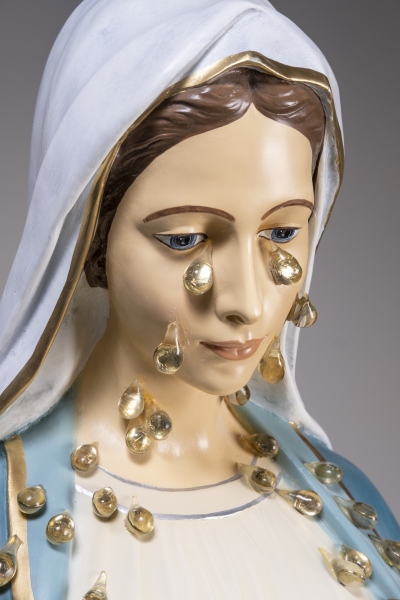Robert Rumas
Las Vegas – niewalaszka
The work by Robert Rumas Las Vegas - Niewalaszka, which is in the Ujazdowski Castle Centre for Contemporary Art collection, is one of four versions of the Las Vegas Madonnas.
The process of creating a sculpture from the Collection was initiated in 1996, when Rumas was making critical art. In the 1990s, its important theme was trivialising and ideologizing Catholic religion, depleting it of spiritual content. In the series entitled Las Vegas Madonnas (1994—1999), consisting of statues of the Virgin Mary of various sizes crying with coins, the artist criticized the commercialization of religion, the market for devotional items, and the entanglement of faith in the political and economic spheres.
Las Vegas Madonnas depicts Our Lady Immaculate that is worshiped mainly by throwing coins at statues. The artist made an epoxy resin cast modelled on mass-produced figures from devotional shops and styled it, fixing coins to its surface – the Virgin is crying tears made of coins embedded in transparent resin, they run down her robes and face, embellishing the figure standing on a golden, spherical base made, among others, from one grosz coins. The work exposes the splendour and shallowness of the language of religious images and the degradation of religious symbols. The title of the sculpture suggests that the artists likens the kitsch of religion and the kitsch of entertainment, and more broadly, it points to business and advertising under the guise of religious worship. In his critique of the financial interests of the Church, Rumas refers to, the tradition of Reformation; a conflict that has been going on in the Christian world for centuries.
Robert Rumas (b. 1966) is a sculptor, he creates objects, installations, interventions, photography, he is also a curator and exhibition and theatre set designer. In 1987–1991 he studied at the Faculty of Painting of the State Higher School of Fine Arts in Gdańsk. As a curator and exhibition designer, he worked with the Wyspa Gallery in Gdańsk, the State Art Gallery in Sopot, the Baltic Sea Cultural Centre in Gdańsk, the Łaźnia Centre for Contemporary Art in Gdańsk, the National Museum in Warsaw, and the Zachęta National Gallery.
Rumas is a representative of critical art. In his early works, he tackled the problem of the contemporary identity of Polish society, based on the traditional role of religion and the Catholic Church, as well as other elements that shape Polish mythology, such as patriotism or nationalist themes. He was interested in the question of society as an object of manipulation in the context of concepts related to religion, nation, and race. His later work is strongly linked to an exploration of social codes, stereotypes, and popular culture fetishes that capture the collective imagination. Often, he explored the intersection of the public and private space, where both overlap and interpenetrate, creating a continually evolving common area.
Between 1998—2004 he has been working on a project intervening in the social fabric of the urban agglomeration, Urban Maneuvers, implemented in many cities in Poland and abroad. In 2009, together with Daniel Muzyczuk, he organized the exhibition We went to Croatan, raising the problem of exclusion in an unconventional way. Another project by Rumas, Allocation (2007), referred to the displacement of capital and labour in the context of the landscape of a post-communist country, specifically a Polish, once stated owned, farm village. In 2006, he made his first set design for Paweł Demirski’s play When They Come To Set The House On Fire, Don’t Be Surprised. Later, he became closely associated with the theatre, cooperating, among others with Michał Zadara, Agnieszka Błońska, and Marta Górnicka.


